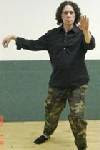MANHATTAN, NEW YORK (July 28, 2008)
In February of 1962, network programming on black and white television was the penultimate unifier of American self-perception. Season two of AMC's dramatic series “MAD MEN” opened with a background motif of Jacqueline Kennedy conducting her famous TV tour of the redecorated White House. All of the Mad Men women viewing together from their respective vantage points captured a perfect moment. I vividly remember my mother (she was “Mom” then) dressing up and applying makeup and jewelry to watch the tour as a nationally televised cultural event. Jackie was coming into our home, albeit via one-way broadcast beams, so one had to look one's very best. Ahh, "for those who think young."
DISCLAIMER: The essay below contains plot spoilers about Season 2, Episode 1: "For those Who Think Young." If you haven't seen that episode, check out the Mad Men schedule on amctv.com to see when encore presentations are airing or download it from iTunes.
It has been 46 years and change since then. These truisms are not trite. America saw itself as a society and a people in very different light at that time. We were the victors of World War Two and the champions of manufacturing. We still believed in our moral certitude. We saw ourselves as the good people that triumph in movies and life. At that juncture, Americans wished to be modern without any reasonable notion what that might mean and would portend. (Is 46, the mystical number of chromosomes, a subliminal message from creator Mathew Weiner alluding to our national DNA?)
White middle-class Americans were clueless to the impending revolutions that had already begun around them. David Halberstam in his history of “The Fifties” wrote what I mysteriously felt when I was finally allowed to see it: When Marlon Brando stepped off his motorcycle in “The Wild One,” that was the instant of electrical discharge and seismic pre-shock. “Brown vs. Board of Education” had been decided almost eight years before; combat boots had already been committed in Vietnam; experimentation with L.S.D. had been entrusted to C.I.A. field operatives.
Social life in 1962 Manhattan was “discos” and the Twist – everywhere. Meanwhile, off-screen and out in the boondocks where those things happen, the musical world was in a phase of rock innovation and dance tunes. At the top of the February 1962 music charts were Little Eva's “Locomotion” and Gene Chandler's “Duke of Earl.” Bruce Channel's “Hey Baby” (best known from the movie “Dirty Dancing”) was climbing the charts as The Drifters' “Up On The Roof” was peaking. “The movie “Twist Around the Clock” was being released in various cities and featured Dion's “Runaround Sue” and “The Wanderer.” Chuck Berry entered federal penitentiary that month on a racially loaded conviction for violation of the Mann Act – transporting a woman across state lines for the purposes of committing immoral acts.
Without over reliance on catchy tunes and soundtrack, Mad Men projects its message with visuals and “messages lines” in similarity to the advertising world of its day. The social underpinnings are under strain but the characters have no sense of what is about to transpire. Let’s watch from a safe distance and see what they learn. ///
Thursday, July 31, 2008
Subscribe to:
Posts (Atom)
